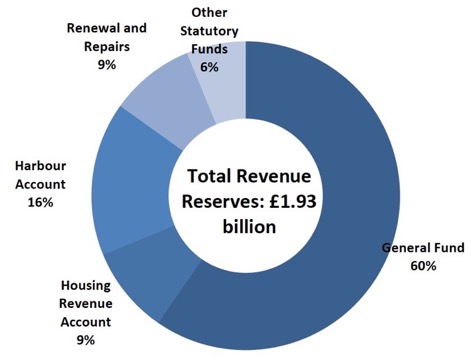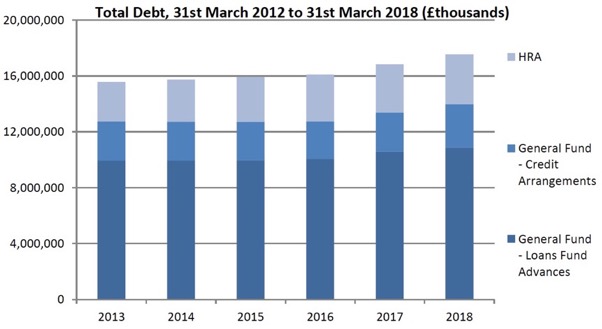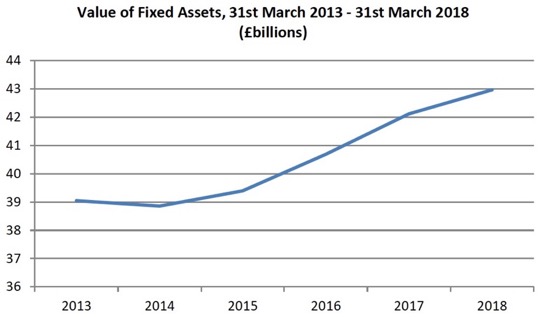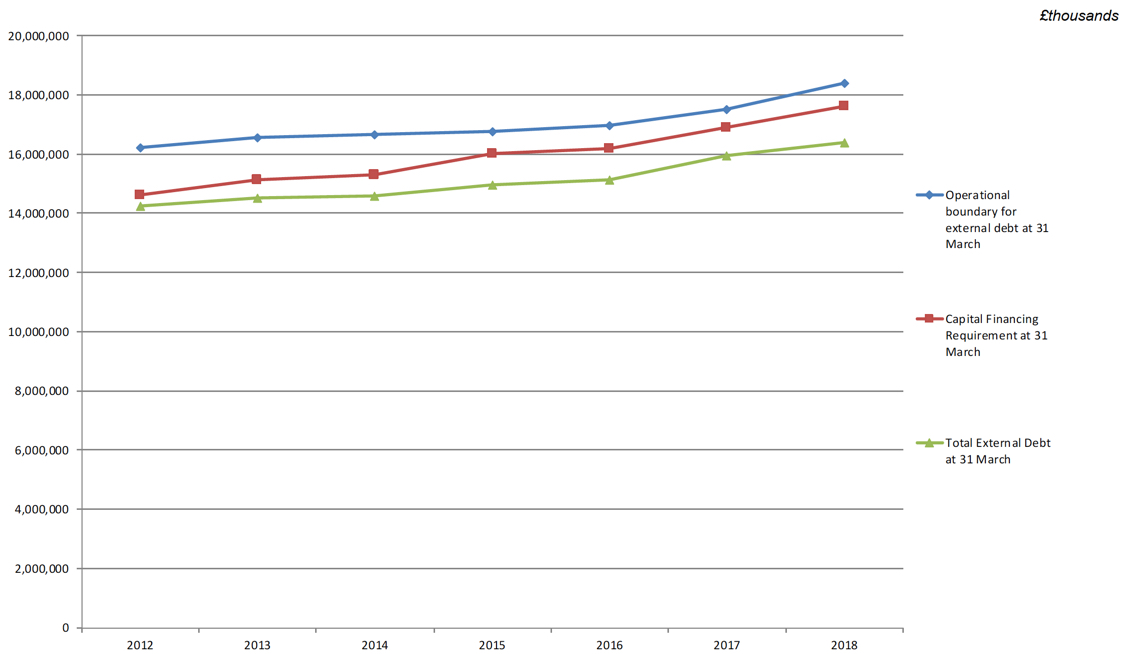Scottish local government financial statistics 2017-2018
Annual publication providing a comprehensive overview of financial activity of Scottish local authorities based on authorities audited accounts.
This document is part of a collection
3. Local Government Reserves, Fixed Assets and Debt
Local authorities can hold reserves to spend on services in the future and borrow to fund capital expenditure that will create an asset.
- Total revenue reserves decreased by 0.9% from £1.95 billion on the 1st April 2017 to £1.93 billion on the 31st March 2018;
- Total Local Authority debt increased by 4.3% from £16.83 billion at the 31st March 2017 to £17.55 billion at the 31st March 2018;
- Value of assets increased by 2.0% from £42.12 billion at the 31st March 2017 to £42.97 billion at the 31st



3.1 Local Authority Debt
Local authority capital expenditure is financed from a number of sources. When this is by borrowing money or a credit arrangement (e.g. finance lease, Public-Private Partnership (PPP) or Private Finance Initiative (PFI)) a debt liability is created to be repaid by the local authority from future revenues.
The Local Authority (Capital Finance and Accounting) (Scotland) Regulations 2016 require a local authority to maintain a Loans Fund. Advances are made from the Loans Fund to record the amount of expenditure a local authority has determined should be met from borrowing as permitted by legislation. The repayments made to the Loans Fund are the amount to be met in each financial year from a local authority revenue budget.
The expenditure recorded in the Loans Fund is expenditure which has been deferred (i.e. not met by taxpayers or housing tenants when it is incurred) and is to be charged to taxpayers or housing tenants over a number of future years. The value of a Loans Fund will increase whenever an advance is made for expenditure incurred, or loans made, in any financial year. The value of the Loans Fund will reduce when Loans Fund advances are repaid by making a charge to the General Fund or Housing Revenue Account. The balance on a Loans Fund at 31 March each year represents the amount of past expenditure a local authority has a liability to fund from its future revenue budgets.
A local authority will borrow externally to fund the expenditure that is deferred and recorded in the Loans Fund. The balance on the Loans Fund should be similar to the value of external borrowing. There may be differences between the two values. Local authorities may borrow internally, that is use cash reserves rather than borrowing externally, or may borrow in advance of incurring the actual expenditure to take advantage of favourable interest rates.
The value of Loans Fund advances outstanding is set out in Table 3.1 and the level of credit arrangements outstanding is set out in Table 3.2.
Following a review of the capital forms in 2015, the timing of the data collection was changed to allow for final, audited capital data to be collected. Prior to this, the data was collected after the financial year had ended, but before the audit of the accounts was complete.
The all-Scotland value of Loans Fund advances outstanding at 31st March 2018 was £14.45 billion (of which £10.88 billion was General Fund and £3.57 billion was HRA). General Fund Loans Fund advances outstanding increased by £296 million (2.8%) between 1st April 2017 and 31st March 2018. HRA Loans Fund advances outstanding rose by £120 million (3.5%) between 1st April 2017 and 31st March 2018.
At 31st March 2018, the Scottish average General Fund Loans Fund advances outstanding was equal to £2,006 per person (up 2.4% on 31st March 2017) and the average HRA Loans Fund advances outstanding was equal to £11,525 per HRA dwelling (up 4.2% on 31st March 2017).
Table 3.1 – General Fund and HRA Loans Fund Advances Outstanding, 2013-14 to 2017-18
£thousands
| 2013-14 |
2014-15 |
2015-16 |
2016-17 |
2017-18 |
|
|---|---|---|---|---|---|
| General Fund |
|||||
| Loans Fund advances outstanding 1 April |
9,650,825 |
9,932,872 |
9,954,276 |
10,067,865 |
10,582,876 |
| ADD New advances from the Loans Fund |
788,568 |
518,296 |
558,669 |
954,113 |
739,527 |
| LESS : Repayments in year |
469,823 |
462,945 |
456,449 |
434,452 |
428,901 |
| LESS : Additional Voluntary Repayments in Year |
34,546 |
27,437 |
8,889 |
3,584 |
13,461 |
| Transfer of assets between funds (transfers out are negative) |
-1,411 |
-1,773 |
-65 |
-3,552 |
-449 |
| Total Loans Fund advances outstanding (£ thousands) |
9,933,613 |
9,959,013 |
10,047,542 |
10,580,390 |
10,879,592 |
| Per Head (£) |
1,865 |
1,862 |
1,870 |
1,958 |
2,006 |
| Housing Revenue Account |
|||||
| Loans Fund advances outstanding 1 April |
2,835,741 |
3,024,509 |
3,219,673 |
3,360,105 |
3,454,161 |
| ADD New advances from the Loans Fund |
316,958 |
311,404 |
272,658 |
224,697 |
254,849 |
| LESS : Repayments in year |
127,585 |
105,602 |
112,504 |
116,884 |
123,707 |
| LESS : Additional Voluntary Repayments in Year |
9,956 |
12,411 |
16,931 |
20,987 |
11,287 |
| Transfer of assets between funds (transfers out are negative) |
1,411 |
1,773 |
65 |
3,552 |
449 |
| Total Loans Fund advances outstanding (£ thousands) |
3,016,569 |
3,219,673 |
3,362,961 |
3,450,483 |
3,574,465 |
| Per HRA dwelling (£) |
9,559 |
10,227 |
10,722 |
11,057 |
11,525 |
| Total (GF + HRA) Loans Fund advances outstanding |
12,950,182 |
13,178,687 |
13,410,504 |
14,041,714 |
14,454,057 |
Source: Capital Returns (CRFinal), Housing Statistics for Scotland, NRS Mid-Year Population Estimates
Credit arrangements such as Private Finance Initiatives (PFI) and Public Private Partnerships (PPP) including the Scottish Non Profit Distributing (NPD) model are not charged to the Loans Fund, but are a form of borrowing and included in the total debt figures.
Total credit arrangements outstanding stood at £3.10 billion on the 31st March 2018, an increase of 10.9% on the previous year. Credit arrangements per head within the General Fund increased by 10.5% to £571 per head, while within the Housing Revenue Account, credit arrangements per HRA dwelling fell by 5.1% to £8 per dwelling.
Table 3.2 – Credit Arrangements, 2013-14 to 2017-18
£thousands
| 2013-14 |
2014-15 |
2015-16 |
2016-17 |
2017-18 |
|
|---|---|---|---|---|---|
| General Fund |
|||||
| Balance brought forward 1 April |
2,845,843 |
2,800,193 |
2,750,910 |
2,675,714 |
2,792,467 |
| ADD: New credit arrangements in year |
30,625 |
42,701 |
21,726 |
207,018 |
396,216 |
| LESS: Repayments of principal in year |
90,802 |
92,895 |
87,933 |
90,265 |
92,470 |
| Credit arrangements outstanding 31 March |
2,785,666 |
2,749,999 |
2,684,703 |
2,792,467 |
3,096,213 |
| Per Head (£) |
523 |
514 |
500 |
517 |
571 |
| Housing Revenue Account |
|||||
| Balance brought forward 1 April |
7,132 |
4,965 |
3,469 |
2,679 |
2,543 |
| ADD : New credit arrangements in year |
0 |
0 |
0 |
0 |
0 |
| LESS : Repayments of principal in year |
2,167 |
1,496 |
790 |
136 |
145 |
| Credit arrangements outstanding 31 March |
4,965 |
3,469 |
2,679 |
2,543 |
2,398 |
| Per HRA Dwelling (£) |
16 |
11 |
9 |
8 |
8 |
| Total ( GF + HRA ) Credit Arrangements Outstanding |
2,790,631 |
2,753,468 |
2,687,382 |
2,795,010 |
3,098,611 |
Source: Capital Returns (CRFinal)
Total debt increased by 4.3% from £16.83 billion on the 31st March 2017 to £17.55 billion on the 31st March 2018. Of this, £13.98 billion was in the General Fund, which equates to £2,576 per head of population and £3.58 billion was in the Housing Revenue Account, which equates to £11,533 per HRA dwelling.
Table 3.3 – Total Debt, 31st March 2014 to 31st March 2018
£thousands
| 31st March 2014 |
31st March 2015 |
31st March 2016 |
31st March 2017 |
31st March 2018 |
|
|---|---|---|---|---|---|
| General Fund |
|||||
| Loans Fund Advances Outstanding |
9,933,613 |
9,959,013 |
10,047,542 |
10,580,390 |
10,879,592 |
| Credit Arrangements |
2,785,666 |
2,749,999 |
2,684,703 |
2,792,467 |
3,096,213 |
| Total General Fund Debt |
12,719,279 |
12,709,012 |
12,732,245 |
13,372,857 |
13,975,805 |
| Per Head (£) |
2,394 |
2,385 |
2,381 |
2,474 |
2,576 |
| Housing Revenue Account |
|||||
| Loans Fund Advances Outstanding |
3,016,569 |
3,219,673 |
3,362,961 |
3,450,483 |
3,574,465 |
| Credit Arrangements |
4,965 |
3,469 |
2,679 |
2,543 |
2,398 |
| Total HRA Debt |
3,021,534 |
3,223,142 |
3,365,640 |
3,453,026 |
3,576,863 |
| Per HRA Dwelling (£) |
9,568 |
10,186 |
10,598 |
11,065 |
11,533 |
| Total Debt |
15,740,813 |
15,932,155 |
16,097,885 |
16,825,883 |
17,552,668 |
Source: Capital Returns (CRFinal)
3.2 Prudential Indicators
The CIPFA Prudential Code sets out a framework for a local authority to demonstrate its capital investment plans are affordable, prudent and sustainable. A number of prudential indicators are set and monitored against three year capital expenditure plans.
Key prudential indicators are:
- Capital Financing Requirement;
- Total External Debt;
- Operational Boundary;
- Authorised Limit.
The Capital Financing Requirement (CFR) represents the amount of capital expenditure which a local authority has determined should be met from borrowing with the repayment of that borrowing to be met from future local authority budgets. Each year the CFR will increase by the amount of new capital expenditure which a local authority has determined should be met by borrowing (which includes both borrowing money and credit arrangements, which includes PPP/PFI) and decrease by the amounts repaid. The CFR only represents an authority’s underlying need to borrow to finance capital expenditure. The actual Total External Debt may be less than the CFR where a local authority has chosen to utilise internal cash reserves rather than borrow externally. The Total External Debt may exceed the CFR where a local authority has chosen to borrow in advance of actual capital expenditure. The Prudential Code limits borrowing in advance to the CFR plus up to 2 years planned capital expenditure to be funded from borrowing.

Local authorities are also required to set limits on external debt.
The Operational Boundary is based on the authority’s capital spending plans and should reflect the most likely, i.e. prudent, but not worst case scenario for borrowing. In general, it is not significant if an authority breaches the operational boundary for a short period, however a sustained or regular trend above the operational boundary would be significant.
The authorised limit represents the maximum amount that the authority may borrow and is set at a level that reflects capital expenditure plans but includes headroom to allow for unusual cash movements i.e. treasury management.
Local authority Total External Debt increased by £0.47 billion (3.0%), from £15.94 billion at the 31 st March 2017 to £16.41 billion at the 31 st March 2018. Local authorities are currently under-borrowed, i.e. utilising internal cash reserves rather than external borrowing, with total external debt as a percentage of the Capital Financing Requirement of 93% at 31 st March 2018.
Table 3.4 - Prudential Information, 2013-14 to 2017-18
£thousands
| 2013-14 |
2014-15 |
2015-16 |
2016-17 |
2017-18 |
|
|---|---|---|---|---|---|
| Capital Financing Requirement at 1 April |
14,893,146 |
15,863,207 |
16,020,231 |
16,197,880 |
16,913,113 |
| Capital Expenditure to be financed by borrowing or credit arrangements |
1,136,151 |
872,402 |
853,053 |
1,385,828 |
1,390,592 |
| Capital Expenditure to be financed by borrowing |
829,701 |
829,701 |
831,327 |
1,178,810 |
994,376 |
| Capital Expenditure to be financed by credit arrangements |
30,625 |
42,701 |
21,726 |
207,018 |
396,216 |
| Loans Fund principal repayments |
597,408 |
568,548 |
568,953 |
558,595 |
552,608 |
| Credit arrangements principal repayments |
92,969 |
94,391 |
88,723 |
90,401 |
92,615 |
| Additional voluntary contributions of principal repayments |
44,502 |
39,848 |
25,865 |
26,359 |
24,748 |
| Change in Capital Financing Requirement |
401,272 |
169,615 |
169,512 |
710,473 |
720,621 |
| Capital Financing Requirement at 31 March |
15,294,418 |
16,032,822 |
16,189,743 |
16,908,353 |
17,633,734 |
| Borrowing at 1 April |
11,558,504 |
11,897,475 |
12,378,022 |
12,465,897 |
13,159,196 |
| Other long term liabilities at 1 April |
2,852,975 |
2,690,905 |
2,648,120 |
2,674,322 |
2,782,628 |
| Total External Debt at 1 April |
14,411,479 |
14,588,380 |
15,026,142 |
15,140,219 |
15,941,824 |
| Borrowing at 31 March |
11,816,384 |
12,332,169 |
12,465,804 |
13,159,196 |
13,332,573 |
| Other long term liabilities at 31 March |
2,790,631 |
2,645,977 |
2,680,311 |
2,782,628 |
3,079,982 |
| Total External Debt at 31 March |
14,607,015 |
14,978,146 |
15,146,115 |
15,941,824 |
16,412,555 |
| Operational boundary for external debt at 31 March |
16,684,872 |
16,779,418 |
16,982,303 |
17,519,099 |
18,415,584 |
| Authorised limit for external debt at 31 March |
17,749,541 |
17,787,296 |
17,733,442 |
19,083,076 |
20,064,032 |
| Total External debt as a percentage of the Capital Financing Requirement at 31 March |
96% |
93% |
94% |
94% |
93% |
Source: Capital Returns (CRFinal)
Chart 3.1 – Prudential Indicators: 31st March 2013 to 31st March 2018

Source: Capital Returns (CRFinal)
3.3 Fixed Assets
Capital Expenditure creates local authority assets. The value of local authority fixed assets is shown in Table 3.5 below. At 31st March 2018, local authorities held a total of £42.97 billion of assets, an increase of 2.0% (£848 million) on 31st March 2017.
Table 3.5 – Value of Fixed Assets, 31st March 2014 to 31st March 2018
£thousands
| Value of fixed assets as at 31 March 2014 |
Value of fixed assets as at 31 March 2015 |
Value of fixed assets as at 31 March 2016 |
Value of fixed assets as at 31 March 2017 |
Value of fixed assets as at 31 March 2018 |
|
|---|---|---|---|---|---|
| Operational Assets |
|||||
| Council dwellings |
10,839,706 |
10,535,999 |
11,281,473 |
11,189,874 |
11,460,363 |
| Other land and buildings |
18,276,923 |
18,866,921 |
18,995,354 |
20,177,171 |
20,714,141 |
| Vehicles, plant and machinery |
1,003,162 |
1,178,814 |
1,197,642 |
1,145,829 |
1,063,300 |
| Infrastructure assets |
4,987,041 |
5,361,011 |
5,608,853 |
5,710,060 |
5,845,085 |
| Community assets |
161,728 |
169,971 |
184,156 |
177,537 |
183,634 |
| Heritage assets |
1,803,074 |
1,840,245 |
1,848,685 |
1,857,999 |
1,878,315 |
| Total operational assets |
37,071,634 |
37,952,961 |
39,116,163 |
40,258,470 |
41,144,838 |
| Non-operational assets |
|||||
| Assets under construction |
1,200,830 |
845,627 |
1,011,066 |
1,316,259 |
1,260,055 |
| Surplus assets held for disposal |
365,120 |
336,021 |
314,377 |
301,251 |
267,138 |
| Investment properties |
197,445 |
207,027 |
197,382 |
192,725 |
241,393 |
| Total non-operational assets |
1,763,395 |
1,388,675 |
1,522,825 |
1,810,235 |
1,768,586 |
| Intangible Assets |
23,913 |
52,306 |
48,437 |
51,435 |
55,078 |
| Total Assets |
38,858,942 |
39,393,942 |
40,687,425 |
42,120,140 |
42,968,502 |
Source: Capital Returns (CRFinal)
There is a problem
Thanks for your feedback